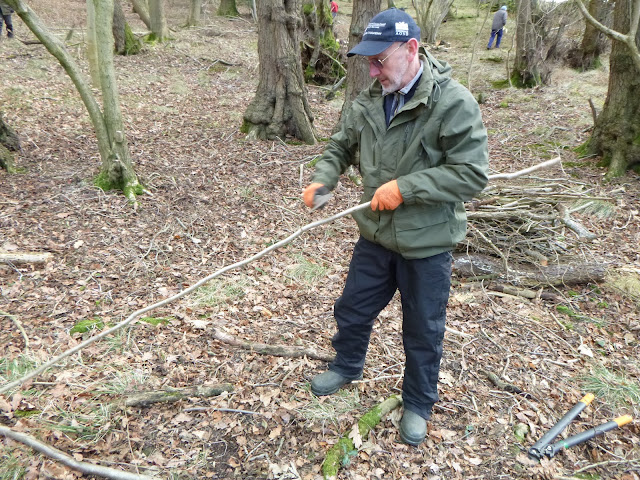What's going on at Mayfield Farm?
Anyone walking past the lower field at Mayfield Farm last Thursday would have been asking themselves this question. Why were two people hammering in these pegs and canes and then decorating them with white, plastic bows?
The answer was simple. Both Tony and Ros E. were preparing the virtually tree free field for a big tree planting task to be started by the NCVs this week. The white 'flags' marked out where a winding path was to be left empty of trees. Apart from this and a 2m wide stretch around most of the perimeter, the rest of the field was fair game for the 650 mixed,native deciduous trees that had been delivered from the Environment Agency.
So - let's see how they got on this week.....
So - let's see how they got on this week.....
The day started with the walk down to the second field.
Everyone was well wrapped up against the cold and possible snow showers.
The second field has been fenced off down the centre.
This half is going to be a woodland.
(The other half has been scarified and seeded with wild flower seeds
to create a wild flower meadow.)
Everyone got busy banging in the tree stakes -
avoiding the flagged path and resisting the urge to make straight lines.
"Let's keep this woodland looking wibbly wobbly please!"
avoiding the flagged path and resisting the urge to make straight lines.
"Let's keep this woodland looking wibbly wobbly please!"
A double row of stakes were inserted near the central fence.
No need to keep this boundary clear as this is where the hawthorn hedge is going.
This will provide a good nesting environment for birds.
The introduction of a hawthorn hedge here meant that the old tree swing was
going to have to go. It would not be good to swing into a thorny wall!!
going to have to go. It would not be good to swing into a thorny wall!!
...it was time for lunch in 'Alwin's Trattoria" where we were all served a wonderful hot meal of cottage pie and green veg followed by a gorgeous fruit tart and custard.
How does she do it?
Everyone was full to capacity - especially after seconds of everything.
THANK YOU SO MUCH ALWIN. YOU ARE A TREASURE!
Unfortunately, during lunch, the predicted snow showers set in and work had to be abandoned. However - All the tree posts were in place, many of the guards were allocated to posts and no fewer than 250 trees were planted. This was a good start to the job which will be completed next Tuesday with help from a group of students from Askham Bryan College.
Some NCVs made use of the outdoor showering facilities
to rid themselves of the mud before heading off home.


























































